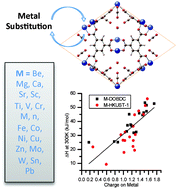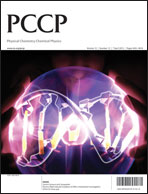Metal–organic frameworks (MOFs) have emerged as promising materials for carbon capture applications due to their high CO2 capacities and tunable properties. Amongst the many possible MOFs, metal-substituted compounds based on M-DOBDC and M-HKUST-1 have demonstrated amongst the highest CO2 capacities at the low pressures typical of flue gasses. Here we explore the possibility for additional performance tuning of these compounds by computationally screening 36 metal-substituted variants (M = Be, Mg, Ca, Sr, Sc, Ti, V, Cr, Mn, Fe, Co, Ni, Cu, Zn, Mo, W, Sn, and Pb) with respect to their CO2 adsorption enthalpy, ΔHT=300K. Supercell calculations based on van der Waals density functional theory (vdW-DF) yield enthalpies in good agreement with experimental measurements, out-performing semi-empirical (DFT-D2) and conventional (LDA & GGA) functionals. Our screening identifies 13 compounds having ΔH values within the targeted thermodynamic window −40 ≤ ΔH ≤ −75 kJ mol−1: 8 are based on M-DODBC (M = Mg, Ca, Sr, Sc, Ti, V, Mo, and W), and 5 on M-HKUST-1 (M = Be, Mg, Ca, Sr and Sc). Variations in the electronic structure and the geometry of the structural building unit are examined and used to rationalize trends in CO2 affinity. In particular, the partial charge on the coordinatively unsaturated metal sites is found to correlate with ΔH, suggesting that this property may be used as a simple performance descriptor. The ability to rapidly distinguish promising MOFs from those that are “thermodynamic dead-ends” will be helpful in guiding synthesis efforts towards promising compounds.


 Please wait while we load your content...
Please wait while we load your content...